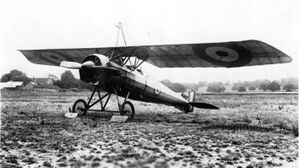Engineering:Morane-Saulnier P
The Morane-Saulnier Type P (official designations MS.21, MS.24 and MS.26) was a French parasol wing two-seat reconnaissance aeroplane of the First World War. Morane-Saulnier built 595 for the French air force, and it was also used by the British until 1916-17.
Development
In addition to being fitted with ailerons and having a more streamlined fuselage, the Type P was faster and better armed than its better known ancestor, the Type L (MS.3) and had a more developed structure compared to the intermediate Morane-Saulnier LA (MS.4).
Three versions were built under Morane-Saulnier's factory designation of Type P, the first being the MS.21, which although externally similar to the Type LA, had its internal structure completely redesigned, with the most visible evidence being the more robust center section struts, and with other details borrowed from the Type N (MS.5), such as a substantial spinner, known as the "casserole".
The MS.24 was built specifically for the Royal Flying Corps to operate alongside their Morane-Saulnier LAs while replacing those lost to attrition, but due to shortages of the 110 hp (82 kW) Le Rhône rotary engine used in the MS.21, it was powered by an 80 hp (60 kW) Le Rhône. The RFC also operated the MS.21.
The MS.26 was similar to the MS.21, but was fitted with a 120 hp (89 kW) Le Rhône engine which was enclosed in a full cowling, and like the 24, dispensed with the spinner commonly found on the MS.21.
Variants
- Type P
- Factory designation
- MS.21
- Official designation of initial version powered with a 110 hp (82 kW) Le Rhône 9J engine
- MS.24
- Official designation of RFC version powered with a 80 hp (60 kW) Le Rhône 9C engine
- MS.26
- Official designation of final version powered with a 120 hp (89 kW) Le Rhône 9Jc engine
- Rouleur/Penguin
- Examples of other variants modified with wing area reduced to act as ground handling trainers.
- Chasseur
- Two examples were converted into single seat fighters, the first had the observer's position covered over, the second had the pilot moved back and the wing lowered.
Operators
 Brazil
Brazil
 France
France
 Japan
Japan
- Imperial Japanese Army Air Service
 Russia
Russia
- Imperial Russian Air Service
 United Kingdom
United Kingdom
- Royal Flying Corps
Specifications (Type P/MS.21)
Data from The Aeroplanes of the Royal Flying Corps (Military Wing) [1]
General characteristics
- Crew: 2
- Length: 7.2 m (23 ft 7 in)
- Wingspan: 11.2 m (36 ft 9 in)
- Height: 3.47 m (11 ft 5 in)
- Wing area: 18 m2 (190 sq ft)
- Empty weight: 433 kg (955 lb)
- Gross weight: 733 kg (1,616 lb)
- Powerplant: 1 × Le Rhone 9J 9-cylinder air-cooled rotary piston engine, 82 kW (110 hp)
- Propellers: 2-bladed fixed-pitch propeller
Performance
- Maximum speed: 156 km/h (97 mph, 84 kn) at 2,000 m (6,600 ft)
- Endurance: 2 hours 30 minutes
- Service ceiling: 4,800 m (15,700 ft)
- Time to altitude: 3,000 m (9,800 ft) in 15 minutes 50 seconds
Armament
- Guns: 1 × Vickers machine gun and 1× Lewis gun or 2× Lewis guns
- Bombs: Light load of bombs
See also
Related development
- Morane-Saulnier Type LA
Related lists
References
Citations
- ↑ Bruce 1982, p. 312.
Bibliography
- Bruce, J.M. The Aeroplanes of the Royal Flying Corps (Military Wing). London: Putnam, 1982. ISBN:0-370-30084-X.
- Cony, Christophe (July 1997). "Aviateur d'Observation en 14/18 (deuxième partie)" (in French). Avions: Toute l'aéronautique et son histoire (52): 10–15. ISSN 1243-8650.
- Davilla, Dr. James J.; Soltan, Arthur (1997). French Aircraft of the First World War. Mountain View, CA: Flying Machines Press. ISBN 978-1891268090.
Further reading
- Lacaze, Henri; Lherbert, Claude (2013) (in fr). Morane Saulnier: ses avions, ses projets. Outreau, France: Lela Presse. ISBN 978-2-914017-70-1.
 |




